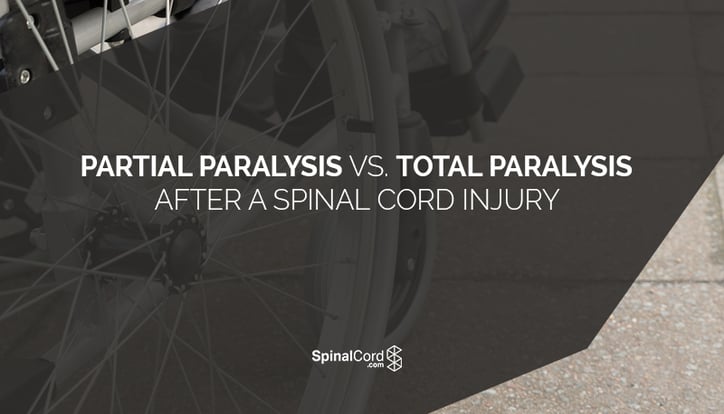Partial Paralysis vs. Total Paralysis After a Spinal Cord Injury

When most people think of a spinal cord injury (SCI) survivor, they envision someone who is fully paralyzed, destined to spend their life in a wheelchair. Spinal cord injuries almost inevitably produce some degree or paralysis, but the extent of the paralysis depends on the location of the injury, as well as its severity. SCI can change over time, particularly with diligent physical therapy, so full paralysis may become partial paralysis, and the areas most affected by your injury can absolutely change with time.
So what's the difference between full vs. partial paralysis? And can you determine which one you will have?
What is Full Paralysis?
Full paralysis is not a medical term, and the truth is even people with extensive paralysis can move some parts of their bodies—usually their faces and necks. The fullest form of paralysis is quadriplegia, sometimes called tetraplegia. This form of paralysis involves diminished or absent movement in the trunk, as well as the arms, legs, hands, and feet. Some common symptoms associated with full paralysis include:
- No or diminished sensation below the site of the injury.
- Difficulty breathing without assistance.
- Swallowing difficulties.
- Difficulty controlling your bowels and bladder.
- Phantom pain anywhere in your body.
What is Partial Paralysis?
Like full paralysis, partial paralysis is not a medical term, and can refer to a broad range of injuries—including those not associated with SCI at all. In the case of spinal cord injuries, the most common form of partial paralysis is paraplegia, which means paralysis of the legs, feet, and most areas below the waist. The effects of paraplegia vary depending on the location of the injury, but generally include:
- Inability to feel or move your legs or feet.
- Inability to walk.
- Difficulty with bowel and bladder functions.
- Difficulty with sexual functioning.
- Phantom pain below the site of the injury.
Very low spinal injuries, as well as spinal injuries that involve only partial compression of spinal cord nerves, can produce a range of symptoms ranging from severe to quite mild. You might, for example, experience numbness or paralysis on one side of the body, have difficulty controlling your bowels or bladder, or experience only intermittent numbness or tingling. These less severe spinal cord injuries tend to provide fewer symptoms as time goes on, since decreased swelling as the injury heals can improve overall functioning.
What Type of Paralysis Will I Have?
The best predictor of the type of paralysis you will have is the location of your injury. Injuries in the cervical spinal cord almost inevitably produce the full paralysis symptoms associated with quadriplegia. The higher your injury is, the more extensive the paralysis will be, and the worse the prognosis will become.
Lower injuries commonly produce paraplegia. Paraplegia can be unpredictable, and the prognosis is generally better with this type of paralysis. You might, for example, regain some functioning below the site of the injury, or only experience intermittent difficulties with movement. While this outcome can inspire some hope, it's important to note that the most common paraplegia prognosis is still full paralysis below the waist.
Partial paralysis due to very low spinal cord injuries is much more unpredictable. Talk to your doctor about your expected prognosis, and ask if there's anything you can do to improve outcomes. Physical therapy for all forms of paralysis can work wonders, since it teaches your brain and spinal cord to work around injuries, and can even promote neuron healing over time.
Can Paralysis Change Over Time?
You've probably heard about formerly paralyzed people who got up and walked one day. While this is certainly possible, it is far from common. Most people with a SCI will remain paralyzed, though the extent and effects of that paralysis may change over time. These changes are rarely miraculous, and more typically involving small improvements in functioning gained as a result of a dogged commitment to physical therapy. Some factors that can affect your prognosis over time include:
- Overall quality of care. Cutting-edge surgeries, experimental drugs, and dedicated attention to new or worsening symptoms can prevent you from suffering serious complications, and may even help you heal more quickly.
- Commitment to physical, ccupational, exercise, and other therapies. These approaches help you work around your injury, and may even retrain your brain and spinal cord to create new neural pathways and work around your injury.
- Reductions in swelling at the site of the injury. If your spinal cord is only partially compressed, then as the injury heals, swelling is reduced, potentially improving your overall functioning.
- Antibiotics and other medications that address swelling, inflammation, and other sources of reduced movement.
- Mental health matters. Your psychological health won't cause you to be paralyzed, but the way you manage your injury can affect the extent of your commitment to your own recovery, thereby either promoting or undermining your recovery.
Only your doctor can predict the outcome most likely in your case, and even then, doctors are sometimes wrong. One thing is certain: a positive (but realistic) outlook can spur you to keep working toward recovery, and this commitment to improved health may improve your prognosis.
Stay Updated on Advancements On Traumatic Brain &
Spinal Cord Injuries
About the Author





